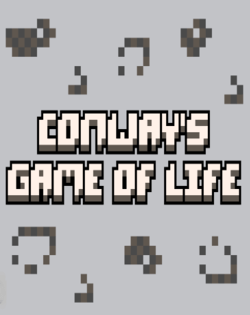
Conway’s Game of Life
GAME INFO

Conway’s Game of Life: A Fascinating Exploration of Cellular Automaton
Conway’s Game of Life is a mesmerizing and thought-provoking simulation game that delves into the fascinating realm of cellular automaton. Invented by mathematician John Conway in 1970, this abstract and captivating game has intrigued players and researchers alike with its simple rules and complex emergent patterns. In this article, we explore the captivating essence of Conway’s Game of Life, shedding light on its mechanics and the mesmerizing patterns that arise through its simulation.
The Basics of Conway’s Game of Life
At its core, Conway’s Game of Life is a zero-player game, meaning that its evolution is determined solely by its initial state. The game unfolds on a two-dimensional grid composed of cells, each of which can be in one of two states: alive or dead. The game’s evolution is governed by a set of rules based on the number of alive neighboring cells for each cell.
Conway’s Game of Life follows three fundamental rules that determine the fate of each cell in the grid. A dead cell with precisely three alive neighboring cells becomes alive in the next generation, simulating birth. An alive cell with two or three alive neighboring cells survives to the next generation, while an alive cell with fewer than two or more than three alive neighboring cells dies, simulating death.
What makes Conway’s Game of Life truly mesmerizing is the emergence of intricate patterns and self-organization from simple initial configurations. Players can create unique initial states and watch as these patterns evolve and interact, giving rise to gliders, oscillators, spaceships, and other mesmerizing structures.
Universal Turing Machine
Beyond its enthralling patterns, Conway’s Game of Life holds significance as a universal Turing machine, meaning it can simulate any computer algorithm. This discovery by mathematician Paul Rendell in 2000 showcases the game’s potential for computational universality.
Conway’s Game of Life has not only captivated gaming enthusiasts but also intrigued researchers and scientists across various disciplines. Its applications extend to studying complex systems, emergent behavior, and the principles of self-organization.
The game’s simplicity and captivating patterns have fostered a vibrant community of enthusiasts and researchers. Conway’s Game of Life has inspired countless variations, rulesets, and computational explorations, keeping the game alive and relevant in modern times.
Conclusion:
Conway’s Game of Life stands as an elegant and profound exploration of cellular automaton, captivating players and researchers with its mesmerizing patterns and self-organization. From its simple rules emerges a rich and intricate world of gliders, oscillators, and spaceships that continue to fascinate enthusiasts and scientists alike. As players experiment with initial states and watch the game’s evolution, they are drawn into a captivating world of emergent complexity and profound scientific significance. Conway’s Game of Life continues to shine as a timeless and thought-provoking exploration of cellular automaton and the beauty of simplicity in complexity.

















